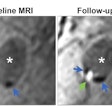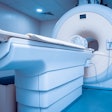A new study from the University of Washington School of Medicine in Seattle found that the added cancer yield of MRI in a clinical population of women with a recent diagnosis of breast cancer is significantly higher than the added cancer yield in high-risk screening studies.
The research also found a high positive predictive value for MRI, with 42% of women undergoing additional tissue sampling being diagnosed with cancer and 12% diagnosed with otherwise occult breast cancer.
"We believe that MRI can improve the detection of cancer both in the ipsilateral and contralateral breast," said Dr. Constance Lehman, vice chair of radiology and head of breast imaging at the University of Washington School of Medicine and director of radiology at the Seattle Cancer Care Alliance. "And, we found no differences in cancer yield based on patients' breast density, age, or the histology of the indexed cancers."
The American Cancer Society recommends MRI in conjunction with mammography to screen women at high risk for breast cancer "because studies to date show an average of 2.2% added cancer yield when MRI is performed in addition to mammography," Lehman noted in the presentation of study results at the 2008 American Roentgen Ray Society (ARRS) meeting in Washington, DC. "In addition, in 2007 the American College of Radiology Imaging Network [ACRIN 6667] reported that MRI detects contralateral, occult cancers in 3% of women with a recent breast cancer diagnosis."
Ongoing MRI debate
However, the debate continues over the appropriate use of breast MRI as a diagnostic tool to determine the extent of the disease in women with a recent diagnosis of breast cancer. Some observers assert that MRI should not be used regularly to determine the extent of breast cancer in recently diagnosed women because studies have been biased with selected patient populations and not representative of all women who are diagnosed with breast cancer, Lehman added.
In contrast, she told ARRS attendees that the University of Washington routinely performs breast MRI on these patients, regardless of breast density or histology of cancer when it is first diagnosed.
The retrospective study reviewed consecutive patients from January 2003 to September 2005 in the practice's database who had a recent diagnosis of breast cancer and underwent breast MRI prior to surgery. Information included a patient's age, breast density, and index cancer histology and size.
Researchers also calculated the positive predictive values of biopsies and overall cancer yield in the ipsilateral and contralateral breast among the 322 patients in the study group and compared the data across patient age, breast density, and index tumor type.
A positive exam was defined as one with a final assessment of category 4 or 5, according to BI-RADS parameters. A negative exam was a final assessment in category 1, 2, 3, or 6, and patients where only the known cancer was identified on the exam with no additional suspicious lesions.
MRI's efficacy
Of the 322 patients, 93 patients (29%) were recommended for additional biopsy for suspicious MRI only lesions. Of those biopsies, 39 cancers were diagnosed. The positive predictive value of the biopsies was 43% and the overall added cancer yield was 12%.
"We did not find significant differences in performance of breast MRI based on either breast density or age," Lehman added during the presentation. "When we first evaluated our fatty versus nonfatty mammographic density breast patients, the added cancer yield was the same."
The study also found no difference in the added cancer yield among younger and older patients. Similarly, there were no significant differences in the positive predictive value of biopsies performed in fatty versus nonfatty breasts.
"We also did not find any statistically significant differences based on the index cancer histology," Lehman said. "We had a small number of added cancers in our patients with ductal carcinoma in situ, but this is not statistically significant."
Diagnostic workups
The study noted that index cancer size was not a significant predictor, with the rates of having cancer yield in patients presenting with a tumor less than 2 cm being similar to those presenting with cancers greater than 2 cm.
In addition, 75% of all additional diagnosed cancers were in the same breast as the known cancer, with the remaining 25% in the contralateral breast. "In other words," Lehman added, "our overall cancer yield was 9% in the ipsilateral breast and 3% of cancers identified in the contralateral breast."
The researchers concluded that the added cancer yield of MRI in women with recent breast cancer diagnosis is significantly higher than in high-risk screening studies, with 12% diagnosed with otherwise occult cancer in this patient population.
"It is important to note that these women will need a diagnostic workup," Lehman added. "We encourage our clinicians to remember this as part of the diagnostic workup. In fact, in this group, 29% of patients underwent additional tissue sampling because of the MRI."
By Wayne Forrest
AuntMinnie.com staff writer
June 13, 2008
Related Reading
Breast MRI with USPIO contrast helps assess lymph node metastases, April 25, 2008
Reimbursement crunch throttles breast MRI CAD users, April 8, 2008
MRI beats mammography, US in detecting breast cancer in high-risk women, March 12, 2008
Catching undetected cancer with MR plus mammo in high-risk women outweighs costs, December 17, 2007
Breast MRI comparable to mammography for detecting later cancers, November 25, 2007
Copyright © 2008 AuntMinnie.com


.fFmgij6Hin.png?auto=compress%2Cformat&fit=crop&h=100&q=70&w=100)





.fFmgij6Hin.png?auto=compress%2Cformat&fit=crop&h=167&q=70&w=250)











